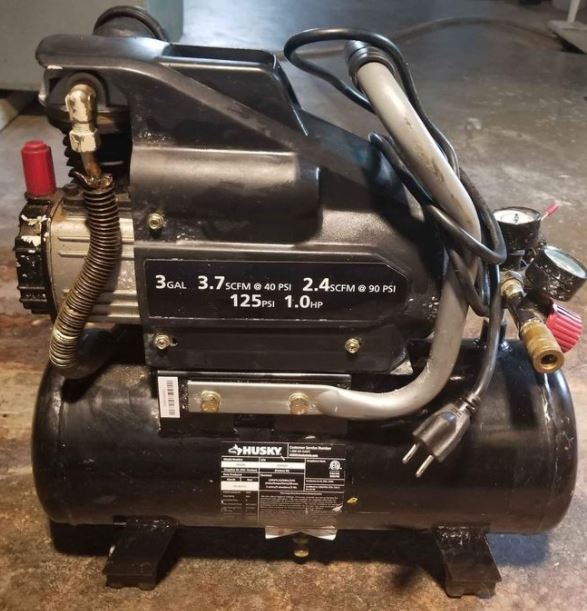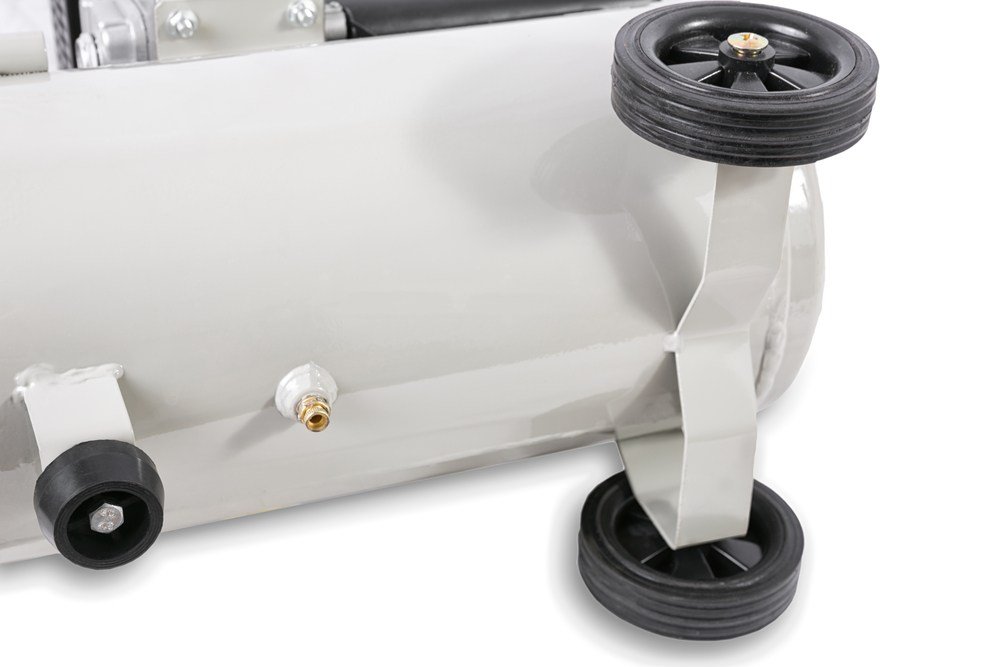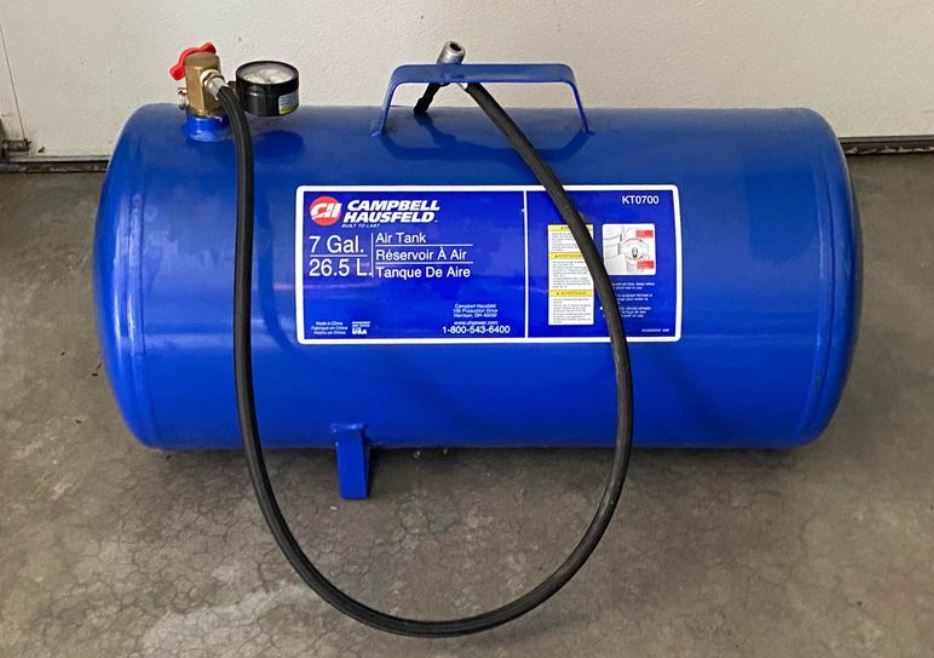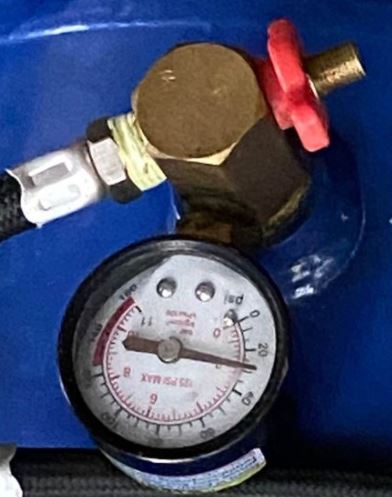
When running regular duty cycles with an appropriate load, a compressor should not run out of air. If the compressor is turned off, the tank can be drained by use or through the drain valve.
If you attach a pneumatic tool with a large air requirement to a tank that is too small, you can empty the air tank. This will require you to stop working and wait while the compressor refills the reserve air supply.
To understand your air needs, consult an air compressor sizing chart to see how much air pressure your impact wrenches and other air tools will need to operate properly.
Tanks are sized by gallons, and larger tanks hold more air, allowing you to use more air at one time.
See Related: Air Compressor History
Do Air Compressors Refill Themselves?
Do you have to refill air compressors? An Air compressor is a tool that collects atmospheric air and condenses it into a tighter space, raising the pressure of the air. This compressed air is stored in an attached receiver tank.
An air compressor should have a pressure switch that signals when the pressure drops in the tank. This starts up the compressor and refills the tank to a pre-specified high-pressure set point, where the compressor shuts off.
Can You Leave Air In The Compressor?

Absolutely, yes, you can leave air in a compressor. In fact, I’ve filled up my pancake compressor just to unplug it and carry the full tank of air out to a car (or tractor) with a flat tire.
It is recommended that you drain the compressor at least once a week to avoid moisture buildup. If you have an older compressor, you may not want to leave air in it as much as there is a higher chance of rusting on the interior of the tank.
One negative problem with leaving the air in a compressor is that on some models, it may create a condition where the compressor will not start. This is rare, thanks to the one-way valves on most compressors. But it is a downside to be aware of.
Always drain your compressor of water condesate when it will be stored for a long time.
How Long Should A Compressor Hold Pressure?
If a compressor has good seals, it should hold pressure indefinitely. However, it is common for the valves, chucks, hoses, or tools to leak.
If you leave a tool plugged into your compressor, it has been my experience that the compressor will empty in a few hours.
However, if you have good seals on all the connections, a compressor should hold pressure for a week or more.
If the compressor is struggling to hold air or does not build air pressure, it likely needs a valve replaced.
How Long Do Compressors Last?
The air compressor tank life expectancy is 10 to 15 years on reciprocating compressors. Most folks know of a well-maintained air compressor that is 30 years or more. As long as a tank is not rusted, does not have pinhole leaks, and does not have weak spots in the wall, it should be safe to use.
If you are concerned about the tank’s integrity, you can generally pay a welding supply company to perform hydrostatic testing of the unit and recertify your compressed air tank.
Can You Fill a Compressed Air Tank At Gas Stations?

A portable air tank that is separate from a compressor, will need a fill station to refill it. We used to keep an air tank in the back of the pickup for working on flat tires on the farm.
You will need a filling station or air compressor with a Schrader air valve (such as you would use to fill car tires) to fill one of these tanks.
Compressed air tanks are a handy tool for folks in the automotive field air that let you carry air pressure into remote areas. Keep in mind that 7.5 gallons of air tank hold about 1 cubic foot of air volume. This isn’t quite big enough to fill a small car tire that is completely flat.
Fill Station
The fill station can be something as simple as a 12v air compressor (if you have the patience to wait for that), or you can use the fill stations at your gas station.
So long as the air compressor you are using has a Schrader connection, you can fill the air tank with no additional tools.
You may need a few quarters unless you can find a free air fill station. Here is a partial list of free air stations.
Air Fill Valve

Yout tank will have an air fill valve on top of it that also serves as the air shut-off valve.
Turning it counter-clockwise should open the tank for filling. Turning it clockwise will help prevent air from escaping.
The plastic ring makes it easy to open and close the valve.
Air Pressure Gauge
An Air pressure gauge is provided on top of the tank to protect you from overfilling the tank and risking an explosion.
These tanks will not exceed the maximum pressure of the air source. To fill a tank all the way, you will likely need an air source capable of 90 pounds per square inch (PSI). Larger compressed air tanks go up to 150 PSI.
The air gauge makes it easy to see how full the tank is.
The heat from the sun is not a known factor in tank explosions.
How To Fill An Air Tank
Pressurized air tanks can be dangerous. It is important to follow best practices.
It is recommended to wear safety glasses anytime you are working around pressurized air.
Step 1: Inspect Tank
Check the tank over for external dents, rust or tiny pinholes along the seams. An old, weak compressed air tank can explode, with disastrous consequences.
Hoses with holes can also waste precious air and make it hard to get enough pressure where you need it. If you see a worn or leaking connector, go ahead and replace it.
Step 2: Open Valve
The fill valve serves as a control valve to open or close the air flow.
Rotate the plastic ring behind the fill valve in a counter-clockwise position to allow air to flow into or out of the tank.
Step 3: Start Air Compressor
Start the compressor or fill station. Fill stations have a limited run time, so be ready to fill the air tank before you start the air compressor.
Step 4: Attach Air Hose
Press the air hose against the fill valve on the air tank. This takes quite a bit of pressure and a straight connection to get a good fill. You will hear air hissing at the start until you get everything lined up.
Step 5: Don’t Overfill
Watch the pressure gauge and stop filling when the PSI reaches the recommended mark. For safety, do not overfill into the red zone on the gauge.
Step 6: Detach and Close Fill Valve
Once filled, remove the air line and close the fill valve to prevent air from escaping.
Where To Fill Paintball Air Tank
Paintball tanks and CO2 tanks need a high PSI air source to be filled.
High-pressure air tanks cannot be shipped making it hard to send them off for a refill. I’ve found four options for refilling my co2 tanks.
Local Paintball Shops: This is the obvious first choice. Call around and find a shop that will refill your tank.
Welding Supply Company: Most paintball shops get their CO2 from a local welding supply company. You’ll need to buy an adapter for your paintball tank, but then you can purchase a large refilling tank from your local welding supply company.
High-Pressure Air Compressor: If you have the equipment and training, you can refill your paintball tank with an HPA compressor, similar to what is used for SCUBA tanks.
Scuba Shop: I’ve never filled my tank at a dive shop, but it should work if you have the correct adapter.
I’ve been asked a lot how to fill a cO2 tank with an air compressor. CO2 tanks require 3,000 PSI to fill, while most air compressors only reach 250 PSI. Don’t try to use a standard air compressor.
Where To Fill Scuba Tank
The obvious choice is to find a supplier who has an HPA compressor with the proper filtration system. Since we’re talking about the air that you will be breathing, and this forces you to reach out to your local dive shop or scuba shop for a refill.
 Skip to content
Skip to content

